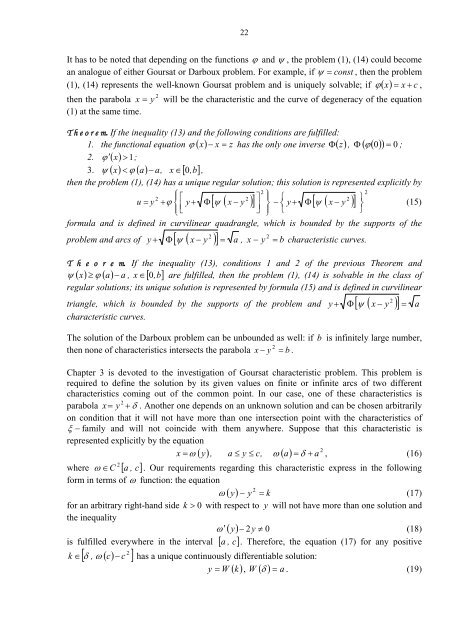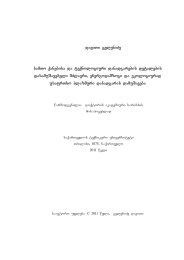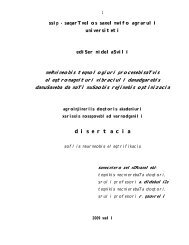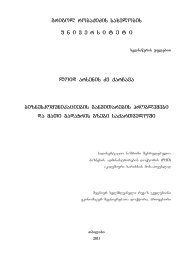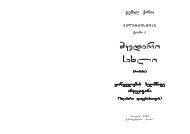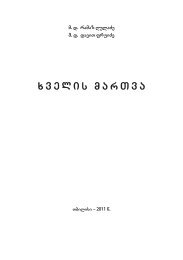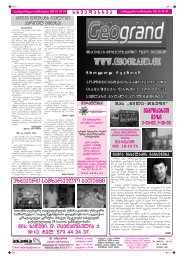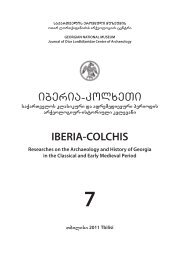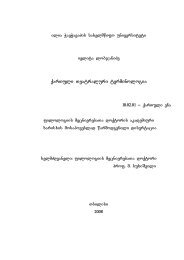Andria Razmadze Mathematical Institute
Andria Razmadze Mathematical Institute
Andria Razmadze Mathematical Institute
You also want an ePaper? Increase the reach of your titles
YUMPU automatically turns print PDFs into web optimized ePapers that Google loves.
22<br />
It has to be noted that depending on the functions ϕ and ψ , the problem (1), (14) could become<br />
an analogue of either Goursat or Darboux problem. For example, if ψ = const , then the problem<br />
ϕ x = x + ,<br />
(1), (14) represents the well-known Goursat problem and is uniquely solvable; if ( ) c<br />
2<br />
then the parabola x = y will be the characteristic and the curve of degeneracy of the equation<br />
(1) at the same time.<br />
T h e o r e m. If the inequality (13) and the following conditions are fulfilled:<br />
1. the functional equation ϕ ( x ) − x = z has the only one inverse Φ ( z)<br />
, Φ ( ϕ ( 0 ) ) = 0 ;<br />
2. ϕ ′ ( x)<br />
> 1;<br />
3. ψ ( x) < ϕ ( a)<br />
− a,<br />
x ∈[<br />
0,<br />
b]<br />
,<br />
then the problem (1), (14) has a unique regular solution; this solution is represented explicitly by<br />
2 ⎪⎧<br />
⎡<br />
u = y + ϕ ⎨<br />
⎪⎩<br />
⎢<br />
y +<br />
⎣<br />
2<br />
2 ⎤ ⎪⎫<br />
⎧<br />
Φ[<br />
ψ ( x − y ) ] ⎥ ⎬ − ⎨ y +<br />
⎦ ⎪⎭ ⎩<br />
2<br />
2 ⎫<br />
Φ[<br />
ψ ( x − y ) ] ⎬<br />
⎭<br />
(15)<br />
formula and is defined in curvilinear quadrangle, which is bounded by the supports of the<br />
2<br />
problem and arcs of y + Φ[<br />
( x − y ) ] = a<br />
ψ , x − y = b characteristic curves.<br />
2<br />
T h e o r e m. If the inequality (13), conditions 1 and 2 of the previous Theorem and<br />
ψ ( x) ≥ ϕ ( a)<br />
− a , x ∈ [ 0 , b]<br />
are fulfilled, then the problem (1), (14) is solvable in the class of<br />
regular solutions; its unique solution is represented by formula (15) and is defined in curvilinear<br />
2<br />
triangle, which is bounded by the supports of the problem and y + Φ[<br />
ψ ( x − y ) ] = a<br />
characteristic curves.<br />
The solution of the Darboux problem can be unbounded as well: if b is infinitely large number,<br />
then none of characteristics intersects the parabola x − y = b .<br />
2<br />
Chapter 3 is devoted to the investigation of Goursat characteristic problem. This problem is<br />
required to define the solution by its given values on finite or infinite arcs of two different<br />
characteristics coming out of the common point. In our case, one of these characteristics is<br />
parabola = + δ . Another one depends on an unknown solution and can be chosen arbitrarily<br />
on condition that it will not have more than one intersection point with the characteristics of<br />
2<br />
x y<br />
ξ − family and will not coincide with them anywhere. Suppose that this characteristic is<br />
represented explicitly by the equation<br />
2<br />
x = ω ( y)<br />
, a ≤ y ≤ c,<br />
ω ( a)<br />
= δ + a , (16)<br />
where C [ a , c . Our requirements regarding this characteristic express in the following<br />
form in terms of<br />
2<br />
ω ∈ ]<br />
ω function: the equation<br />
( y ) − y = k<br />
2<br />
ω (17)<br />
for an arbitrary right-hand side k > 0 with respect to y will not have more than one solution and<br />
the inequality<br />
ω ′ ( y)<br />
− 2y ≠ 0<br />
(18)<br />
is fulfilled everywhere in the interval [ a , c]<br />
. Therefore, the equation (17) for any positive<br />
2<br />
k ∈[ δ , ω () c − c ] has a unique continuously differentiable solution:<br />
y = W k , W ( δ ) = a . (19)<br />
( )


